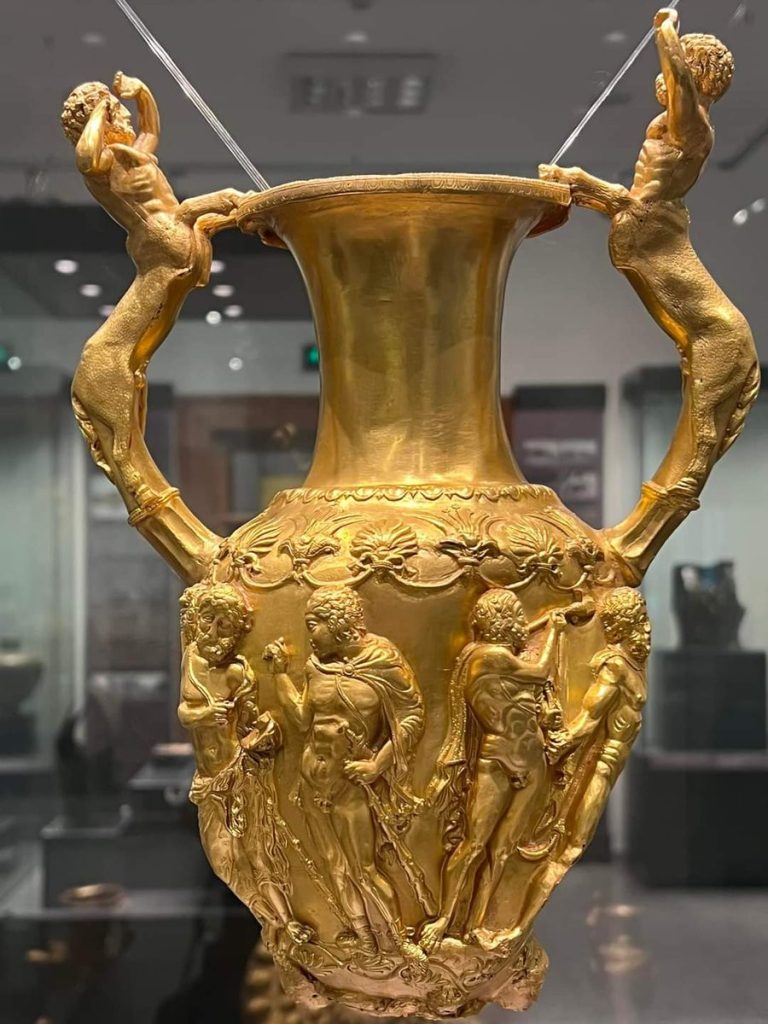In 1949, the quiet Bulgarian town of Panagurishte became an unexpected focal point of global archaeological interest. What began as an ordinary workday for three brothers—Pavel, Petko, and Michail Deikov—turned into a discovery that would leave a permanent mark on the study of ancient civilizations. As they worked at a local clay pit, the men stumbled upon a set of exquisitely crafted gold artifacts buried beneath the earth. This remarkable find, dating back to the 4th century BC, soon gained worldwide recognition as the Panagurishte Treasure, a collection that offers valuable insights into the artistic achievements and cultural interconnectedness of the Thracian and Hellenic worlds.

The Panagurishte Treasure consists of nine stunning gold vessels, all made of solid 24-karat gold, with a combined weight of over six kilograms (approximately 13 pounds). Each piece demonstrates exceptional craftsmanship and serves as a testament to the sophistication of ancient Thracian society. The artistry reflected in these artifacts reveals a people who were not only adept at metalworking but also deeply influenced by the myths, symbols, and stylistic elements of their Hellenic neighbors. These objects are believed to have been used during ceremonial or ritual occasions, possibly in connection with royal banquets or religious rites. While every item in this treasure trove is fascinating in its own right, one piece in particular has captured the imagination of historians and art enthusiasts alike: the Centaur Amphora-Rhyton.
Weighing an impressive 1.7 kilograms (nearly four pounds), the Centaur Amphora-Rhyton stands as the largest and arguably the most visually striking item in the Panagurishte collection. The term “rhyton” refers to a type of drinking or libation vessel that was commonly used in ancient rituals, often fashioned in imaginative forms that reflected religious or mythological symbolism. The amphora-rhyton is an elegant fusion of two vessel types—a standard amphora, typically used for storing liquids like wine or oil, and a rhyton, designed for pouring or drinking. Its dual function symbolizes the blending of practical utility with ceremonial significance, a feature that underscores the cultural and artistic sophistication of its makers.
What truly sets the Centaur Amphora-Rhyton apart, however, is its breathtaking design. The handles of the vessel are intricately sculpted to resemble centaurs, the legendary beings from Greek mythology known for their dual nature—half man, half horse. These centaurs are depicted in a dynamic, lifelike pose: each drawing back a bow, poised to release an arrow. The attention to anatomical detail and the sense of motion captured by the ancient artisans is nothing short of extraordinary. From the musculature of the human torsos to the flowing lines of the horse bodies, the craftsmanship reflects a deep understanding of both form and function. The centaur, often associated with themes of wildness, knowledge, and transformation in Hellenic mythology, serves as a powerful symbol within the context of the vessel’s use and significance.
Beyond its artistic brilliance, the amphora-rhyton holds immense cultural value as an artifact that embodies the fusion of Thracian and Hellenic influences. While the Thracians were an independent and distinct group, their proximity to the Greek world fostered extensive cultural exchange, as evidenced by the adoption and reinterpretation of Greek myths and motifs in Thracian art. The centaur motif, clearly of Hellenic origin, integrated seamlessly into the vessel’s design, illustrating how Thracian artisans were not merely imitators but active participants in a dynamic exchange of ideas. This synthesis of cultures helped shape the artistic identity of the region and provides modern scholars with a clearer picture of the interconnectedness of ancient societies.
Today, the Centaur Amphora-Rhyton has found a new home at the prestigious British Museum in London, where it continues to attract the attention of visitors from all corners of the globe. As part of the museum’s renowned collection of ancient artifacts, this extraordinary piece stands proudly among other treasures from antiquity, offering a tangible connection to a world long past. Its presence in the museum ensures that this legacy is preserved and shared, allowing new generations to engage with the rich cultural tapestry of the ancient world. The exhibit provides an opportunity for people to reflect on the universal themes of creativity, identity, and cultural exchange that transcend time and geography.
For historians, archaeologists, and casual observers alike, the Centaur Amphora-Rhyton remains a timeless wonder. Its combination of technical mastery, mythological resonance, and cultural significance renders it far more than a simple object of beauty—it is a window into a complex and vibrant past. Through this vessel, we gain insight into the beliefs, practices, and values of the Thracians, as well as the broader Hellenic influence that shaped much of the ancient Mediterranean world. The amphora-rhyton reminds us that art and culture are never static, but constantly evolving through the interaction of different peoples and ideas.
As we continue to study and admire such treasures, we are reminded that history is not just a record of events but a living dialogue between the past and the present. The Centaur Amphora-Rhyton, with its intricate design and rich symbolism, serves as a compelling chapter in that dialogue—a chapter that encourages us to appreciate the complexity of ancient civilizations and the enduring power of human creativity. Whether viewed through the lens of archaeology, art history, or cultural studies, this remarkable artifact stands as a lasting testament to the ingenuity and vision of the ancient world, inspiring us to explore, learn, and preserve the legacy of those who came before us.





